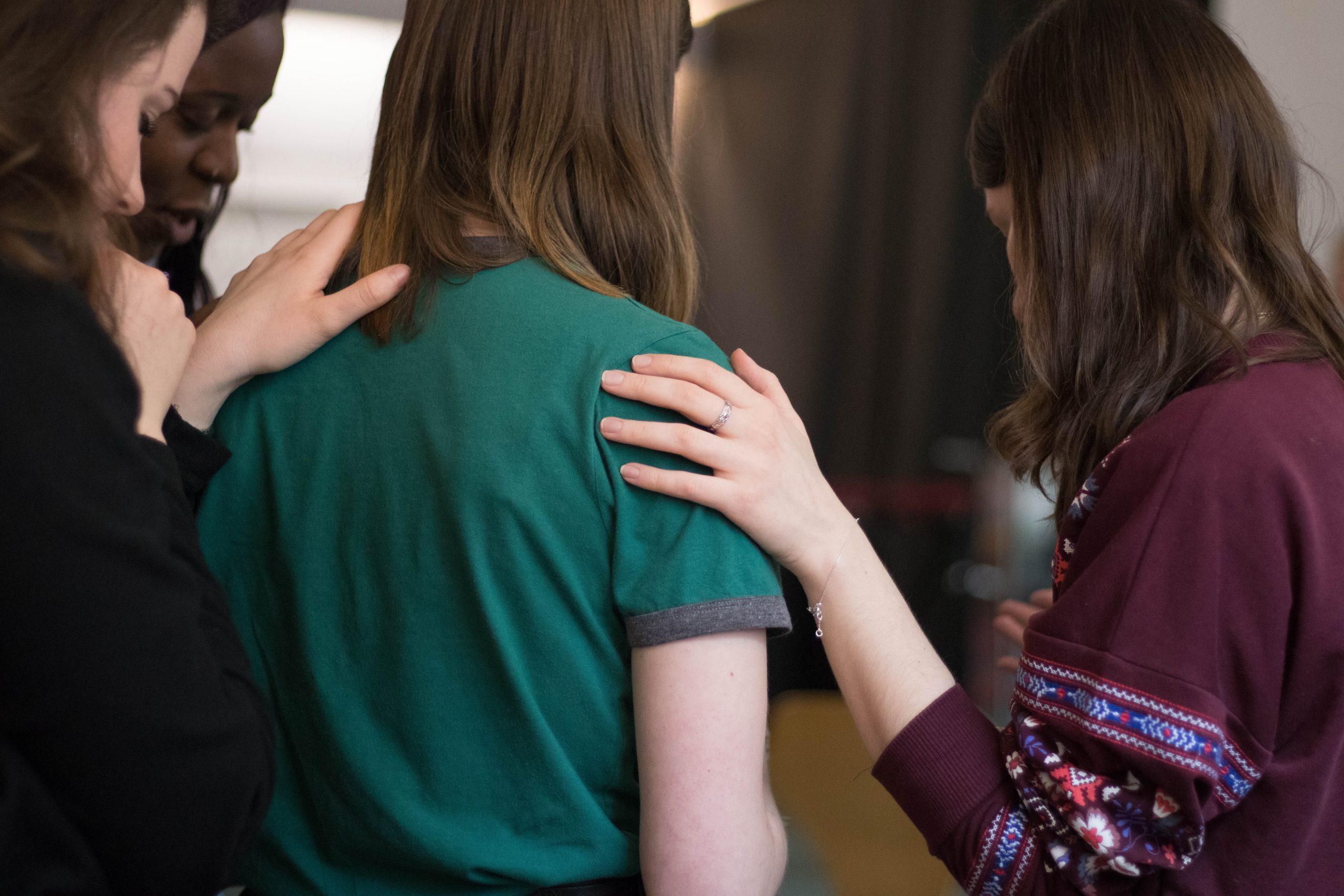
Setting Up Recovery Groups For Women Who Struggle with Porn
This post is part of our Porn in Church series- a series designed especially for pastors. If you are not a pastor, please share this post with your pastor. (This post is also part of my book, Quenched.)
Women in your church struggle with pornography. That’s just a fact. Men in your church struggle with pornography. That’s also a fact.
Still, churches today are relatively ill-equipped to help either gender effectively. When it comes to addressing pornography use and helping people find freedom and healing, too often the message is short and limited to “stop it.”
“Stop it” isn’t helpful.
People who are looking for help breaking free from pornography already want to stop. That’s why they’re looking for help. Many are desperate, trying to find the answer of how to stop. They are looking for practical resources, answers, and support to help them take the steps they need to experience freedom. As a church, we have the opportunity to shepherd people along that journey to freedom. An effective way to do this is to set up support or recovery groups. Personally, I like to call them community groups, but you can brand them however you would like.
Support and recovery groups are a practical way for us to help encourage women on their walk of freedom.
Here are five steps to setting one up.
1. Find a good leader
Any group is only as strong and healthy as the person leading it. A woman’s recovery group should be facilitated by a woman who is passionate about helping women find healing and freedom. She should be trustworthy and discerning. No woman is going to trust and open up to a woman who is a known gossip or judgmental. Likewise, no man should be facilitating a women-only group. Choose a leader you trust because you are going to need to trust her.
She does not have to have prior experience with this struggle. So many pastors and leaders fall into the trap of believing that they need to find a woman who used to struggle with porn in order to lead a group of women who struggle with porn. That is not the case. Why? Because these groups should be more about where you are going and less about where you are/have been.
That being said, once you start opening the discussion about the issue of women struggling with pornography, you may find leaders naturally emerge. You never know until you ask.
I spoke at a church once and shared my story and shared that the church was wanting to minister to women who struggled. Afterward, a woman came up to me and shared that she had never told anyone except her husband but she used to be an adult actress. She was afraid to tell people in the church because she was afraid of being judged but now that the church was openly discussing the issue, she was going to go to the pastor and offer to help however she could. That pastor had no idea that one of his youth leaders had the perfect story to be able to minister to women- young and old- in his church.
Don’t simply reach out to some deacon’s wife because she seems like a great fit. Let God call the leader; not you.
2. Determine the Mission
What is the point of the group? Is it going to be an 8 week long study and then dissolve? Is it going to be something more long-term? Is it a program women “graduate” from or is it a community they can be a part of indefinitely? Is the point intensive recovery or is it more a form of support?
Those are questions you need to answer based on what resources are available to you and your people. Each has its own benefits, but the important thing is that the group has a defined and clear mission from the start. What is the purpose and how are you planning to accomplish that? What materials or resources are you going to use?
One of the pitfalls of “support groups” is that they become sounding boards instead of places of growth. They are not meant to be a place where we can meet up just to talk about pornography. It becomes a club where everyone is trying to outdo everyone else’s story or people are more interested in “getting things off their chest” than they are actual healing.
Defining the purpose and mission of the group from the beginning helps keep it on track. Likewise, setting a fixed time (8 weeks, 6 months, 1 year, etc) gives clear expectations and builds in an opportunity to reevaluate. If things aren’t working after 6 months, you have an opportunity to pause, reassess and try a different approach if needed.
3. Be Discreet
Yes, you are being open and honest about the fact that Christian women struggle with porn. However, when you are setting up this group, exercise a bit of discretion. Do not, for instance, put an announcement in your bulletin calling for all women who struggle to come forward to the front after church for a brief meeting. Do not post a sign outside of the classroom door saying, “Support for women who struggle with pornography.” In my opinion, no one but the women in the group (and leadership) should know when and where the group meets.
My recommendation would be to have the group meet in someone’s home or in off-hours at the church. Do not advertise the meeting place or time. Instead, have women reach out to the leader individually to discuss joining the group and to figure out more information. This helps to make women feel more comfortable but also protects them from would-be predators.
Imagine the worship leader who wants to get help being afraid of someone in the church seeing her walk into a “women struggle with porn” meeting. Or imagine the young girl who struggles with porn, being dropped off at the church and some predatory janitor spies her. He now knows she has a sexual struggle and is vulnerable and now he knows where to find her every Thursday night at 6.
You might announce that you have a woman’s group forming for this, introduce the leader and then say any interested women can reach out to her personally at her email or a specific phone number or reach out to the church office. She can then disclose the meeting time and location. Keeping the group discreet communicates that you want to protect these women, not that you’re ashamed of them.
4. Establish Confidentiality
What’s the first rule of fight club? We don’t talk about fight club. Have members of the group commit to confidentiality. They are not to disclose who is in the group or what is talked about in the group. This includes the leader. For this reason, having two women co-lead may be very beneficial as they will be able to talk things through with each other.
Women will not feel comfortable opening up and sharing their struggles if they know the group leader is giving the pastor a weekly play-by-play. Obviously make exceptions for cases where criminal activity is disclosed or where life is in danger. Have a course of action already established for such cases.
Yes, the leader should let you know how the group is going and any issues she may be running into. However, she should not be sharing that group member Betsy really opened up last time and shared all about a rape that happened in college, etc. What is shared in the group needs to be protected.
You may draw up a contract of sorts, a promise of commitment and confidentiality. If it is an 8-week course, for instance, you may have the member commit to attending all 8 weeks as a condition of joining the group. Additionally, she agrees not to disclose who is in attendance or what other people have shared. She is always welcome to share what she is learning, but should never disclose personally identifying information or stories from other people in the group.
5. Have Backup
Unless you are a certified counselor, you are not a certified counselor. The woman leading your group is likely not a certified counselor (if you have one who is willing to lead a group like this- jump on that!).
These sorts of groups can uncover lots of brokenness and pain. They can unearth sexual trauma, abandonment issues, suicidal thoughts, body image issues and so much more. It’s not your job or your group facilitator’s job to fix any of that. Be willing to admit when you are in over your head and have a backup that you can refer people to. You may even ask that counselor to show up one week just to introduce herself and to schedule preliminary appointments with women who would like one.
This was a process used by a college where I presented and it was hugely successful. By the end of the evening, every available counseling slot for the next two days was filled and the school’s counselor had to increase her hours.
Additionally, I would recommend that your group facilitator meet with a counselor as a condition of leading the group. Leading groups like this and hearing other people’s stories can wear on someone. She is going to need a healthy place to be able to discuss that with someone who has the same commitment to confidentiality and has no skin in the game.
An alternative you can also consider is to look into a coach or pastoral counselor who is experienced with these issues. I highly recommend my friend, Crystal with Living on Purpose. (That is not an advertisement.) Speaking with someone who has experience counseling and working with women who struggle with pornography can be a useful resource for your group leaders.
How this can all look in real life.
Let’s wrap this all up into a practical run down of what this can look like in a real church.
First Church in Smalltown USA is a church of 250 people, 50% of which are women. The pastor, Bill, acknowledges that statistically there are probably 30-40 women (if not more!) in his church who may struggle with pornography.
As a first step, Bill begins to preach about the importance of grace and how God’s grace redeems us and sets us free. He tackles tough issues like pornography and is sure to say that pornography can be a struggle for women too. As part of that, he mentions they want to start a recovery group for women and asks anyone interested in leading to please reach out to him.
After interviewing the five women who came forward, Bill and the elders prayerfully choose Susan and Dana to co-lead a recovery group at Susan’s house on Thursday evenings. They discuss the purpose of the group and decide to trial run a 10-week study using Harvest USA’s new Sexual Faithfulness curriculum. Susan and Dana agree to meet with a local Christian counselor, not affiliated with the church, every other week while the group is meeting.
Together, they draft an expectation of involvement for the group. They discuss what sorts of things they must report and how to report it. Additionally, they talk about the expectation of confidentiality both for themselves and for the team members.
Once all of the pieces are in place, Bill makes the announcement that a group for women will be starting in a couple weeks. He brings Susan and Dana up to the stage to introduce them to the women of the church. Each takes a few minutes explaining why they are passionate about this and then explaining how the group is set up. Women who are interested are encouraged to reach out to Susan or Dana for more information.
Women reach out to Susan/Dana and are told the times the group is meeting as well as the expectation of involvement. Once they agree and sign, they are told where the group is meeting.
The group begins meeting at Susan’s house. Every member has committed to confidentiality and is made aware that any criminal or life-threatening information will be reported. They are also given the information for a counselor if they feel they need further help.
The group meets weekly for 10 weeks. During that time, some women experience breakthroughs in freedom, others are still struggling. Before “disbanding,” each member comes up with a battle plan for what they are going to do next. Based on the success of the group, Dana approaches Bill and offers to continue hosting the same group every week for the next year as a way to encourage and grow in community. The following year, Bill addresses the issue again and the second season of the recovery group forms.
Cost Breakdown
Because I know cost is often a factor when it comes to decisions like this for churches, I wanted to offer a little breakdown for a group of 20 women with two facilitators who meet at a private home for ten weeks. Understandably, the cost of counseling is going to vary depending on the area and the counselor. I used $100/hr because it seems to be right in the average range.
- Sign up for Covenant Eyes’ new Women’s Content and access training videos and material from the S.H.E. Virtual Summit: Free
- Download Harvest USA’s new book Sexual Faithfulness: Gospel-Infused Practical Discipleship for Women: Free
- Harvest USA’s Leader’s Guide for Sexual Faithfulness: Free
- Offer one month of Covenant Eyes Internet Accountability for every group member: $15.99/month (Use code “beggarsdaughter” to get 30 days free. You can also reach out to Covenant Eyes if you would like to discuss options for your entire church).
- Counseling for two leaders (one hour every two weeks @ $100/hr): $1000
- Weekly snack stipend ($25/week): $250
As you can see, there are ways to pull this group off that require little to no cost on the part of the church. The new material made available by Harvest USA even includes teaching videos to accompany the book.
You can find other resources here. Some are free; others are not. Some churches have even used my book, Beggar’s Daughter as a part of their curriculum. Reach out to me and I can send you bulk copies at a reduced rate (fun fact: this is how I met my husband).
Important Things to Remember
As you embark on this journey of setting up support groups for women in your church, here are some important points to remember:
- Take care of your leaders- this can be emotionally exhausting work. Check in on them and be sure they are not taking on too much.
- Not every woman will come forward the first time. Be willing to start small and try this twice.
- The purpose of these group isn’t “get women to stop watching pornography.” It’s to have women experience freedom, healing, and the abundant life God promises them.
- Freedom takes time. Do not expect a 100% success rate at the end of a 10 week course. In my own journey, it took well over a year before I would say I experienced freedom. Factor that reality into your expectations for this group.
Pastor, my prayer for you and your church is that it will become a beacon of grace for women who struggle with pornography. I pray that these women would be set free from shame and come to experience the freedom found in Jesus. That, even when it makes some people uncomfortable, you would not shy away from confronting evil and the chains that have taken so many captive. Your church is filled with prisoners, pastor, and I pray that, with God’s help, you will be able to storm the enemy lines and set those prisoners free.



